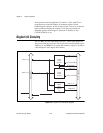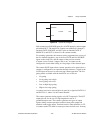
Chapter 3 Theory of Operation
AT-MIO-16X User Manual 3-30
©
National Instruments Corporation
The RTSICLK line can be used to source a 10-MHz signal across the
RTSI bus or to receive another clock signal from another AT board
connected to the RTSI bus. BRDCLK is the system clock used by the
AT-MIO-16X. Bits in a command register in the AT-MIO-16X register
set control how these clock signals are routed.
The RTSI switch is a National Instruments custom integrated circuit
that acts as a 7×7 crossbar switch. Pins B<6..0> are connected to the
seven RTSI bus trigger lines. Pins A<6..0> are connected to seven
signals on the board. The RTSI switch can drive any of the signals at
pins A<6..0> onto any one or more of the seven RTSI bus trigger lines
and can drive any of the seven trigger line signals onto any one or more
of the pins A<6..0>. This capability provides a completely flexible
signal interconnection scheme for any AT Series board sharing the
RTSI bus. The RTSI switch is programmed via its chip select and data
inputs.
On the AT-MIO-16X board, nine signals are connected to pins A<6..0>
of the RTSI switch with the aid of additional drivers. The signals
GATE1, OUT1, OUT2, SOURCE5, OUT5, and FOUT are shared with
the AT-MIO-16X I/O connector and Am9513A Counter/Timer. The
EXTCONV* and EXTTRIG* signals are shared with the I/O connector
and the data acquisition timing circuitry. The TMRTRIG* signal is
used to update the two DACs on the AT-MIO-16X. These onboard
interconnections allow AT-MIO-16X general-purpose and data
acquisition timing to be controlled over the RTSI bus as well as
externally, and allow the AT-MIO-16X and the I/O connector to
send timing signals to other AT boards connected to the RTSI bus.


















